1.4 Combining Forms
Combining forms are the combination of the root and the combining vowel. The root gives the essential meaning of the medical term. The combining vowel is usually an o but occasionally an i.
The following tables go through some of the most common combining forms, their meaning, and an example of a medical term that uses the combining form. Illustrations, key concept textboxes, and review questions are included to help you better understand the combining forms. It is very important that you become familiar with all of them. Making flashcards and reviewing them daily is very important when learning a new language.
Table 1.1. Combining Forms
| COMBINING FORM | MEANING | EXAMPLE OF USE IN MEDICAL TERMS |
|---|---|---|
| abdomin/o | abdomen | abdominal |
| aden/o | gland | adenoma |
| amni/o | amnion sac | amniocentesis |
| an/o | anus | anal |
| append/o | appendix | appendectomy |
| angi/o | vessel | angiogram |
| arteri/o | artery | arteriosclerosis |
| ather/o | plaque | atherosclerosis |
| arthr/o | joint | arthritis |
| axill/o | armpit | axillary |
| bi/o | life | biology |
| bronch/o | bronchial tube | bronchitis |
| bronchi/o | bronchial tube | bronchiectasis |
| carcin/o | cancer | carcinoma |
| cardi/o | heart | cardiology |
| carp/o | wrist | carpals |
| cephal/o | head | cephalic |
| cerebr/o | cerebrum | cerebrovascular accident |
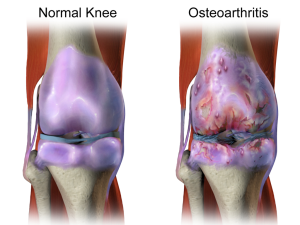
Key Concept
Fig. 1.1 is an image of a normal knee and a knee that has osteoarthritis. If you break this term apart, it means “inflammation” (-itis) of the “bone” (oste/o) and “joint” (arthr/o). Note that the combining vowel is dropped because the suffix starts with a vowel.
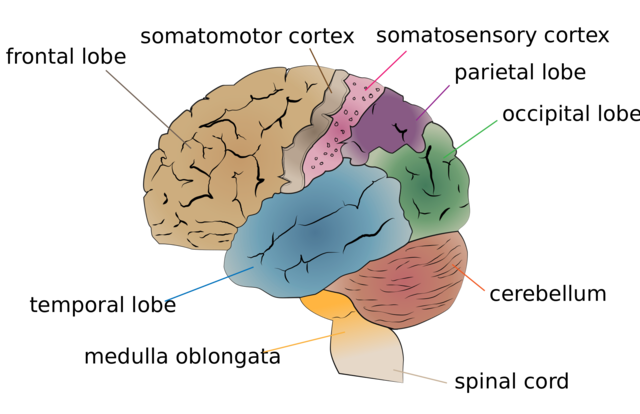
Key Concept
Fig. 1.2 identifies the lobes of the cerebrum. If you break down this term, it means a “structure” (-um) surrounding the “cerebrum” (cerebr/o). Note that you drop the combining vowel because the suffix begins with a vowel.
Exercises
Table 1.2. Combining Forms
| COMBINING FORM | MEANING | EXAMPLE OF USE IN MEDICAL TERMS |
|---|---|---|
| chem/o | drug | chemotherapy |
| cholecyst/o | gallbladder | cholecystectomy |
| chron/o | time | chronic |
| col/o | colon | colitis |
| cost/o | ribs | intercostal |
| crani/o | skull | craniotomy |
| cry/o | cold | cryotherapy |
| cutane/o | skin | cutaneous |
| cyst/o | urinary bladder, sac with fluid | cystoscope |
| cyt/o | cell | cytology |
| derm/o | skin | dermal |
| dermat/o | skin | dermatology |
| dur/o | dura mater | epidural |
| electr/o | electricity | electrocardiogram |
| encephal/o | brain | electroencephalogram |
| enter/o | intestine (usually small) | enteritis |
| erythr/o | red | erythrocyte |
| esophag/o | esophagus | esophageal |
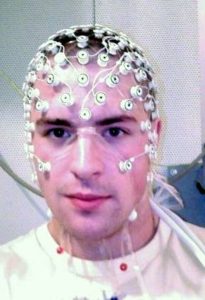
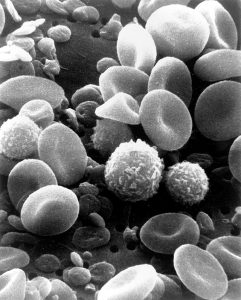
Key Concept
An electroencephalogram (EEG) is a common diagnostic test that looks at the electrical activity of the brain. This term means “to record” (-gram) “electricity” (electr/o) in the “brain” (encephal/o). Fig. 1.3 shows a patient getting an electroencephalogram.
Fig. 1.4 is an image of several different types of blood cells. The larger disc-shaped ones are erythrocytes (red blood cells), the round, fuzzy cells are leukocytes (white blood cells), and the tiny disc-shaped cells are thrombocytes (platelets). The term erythrocyte comes from the suffix -cyte, meaning “cell,” and the combining form erythr/o, meaning “red.” Literally, it means “cell that is red” or, more commonly, “red blood cell.”
Exercises
Table 1.3. Combining Forms
| COMBINING FORM | MEANING | EXAMPLE OF USE IN MEDICAL TERMS |
|---|---|---|
| gastr/o | stomach | gastralgia |
| glyc/o | sugar | hyperglycemia |
| gnos/o | knowledge | diagnosis |
| gynec/o | women, female | gynecology |
| hem/o | blood | hemoglobin |
| hemat/o | blood | hematology |
| hepat/o | liver | hepatitis |
| hyster/o | uterus | hysterectomy |
| inguin/o | groin | inguinal |
| isch/o | to hold back | ischemia |
| lapar/o | abdomen | laparotomy |
| laryng/o | voice box | laryngitis |
| later/o | side | lateral |
| leuk/o | white | leukocyte |
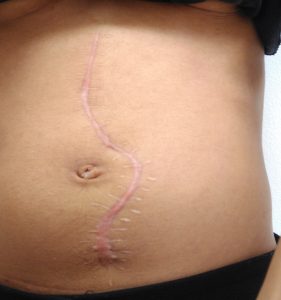
Key Concept
A laparotomy scar is shown above in Fig. 1.5. This term means “to cut” (-tomy) into the “abdomen” (lapar/o).
Exercises
Table 1.4. Combining Forms
| COMBINING FORM | MEANING | EXAMPLE OF USE IN MEDICAL TERMS |
| mamm/o | breast | mammography |
| mast/o | breast | mastectomy |
| men/o | menses | menorrhea |
| mening/o | meninges | meningitis |
| my/o | muscle | myalgia |
| myel/o | spinal cord, bone marrow | myeloma |
| nat/i | birth | neonatal |
| necr/o | death | necrosis |
| nephr/o | kidney | nephritis |
| neur/o | nerve | neuralgia |
| onc/o | tumour | oncology |
| oophor/o | ovary | oophorectomy |
| ophthalm/o | eye | ophthalmoscopy |
| oste/o | bone | osteoarthritis |
| ot/o | ear | otalgia |
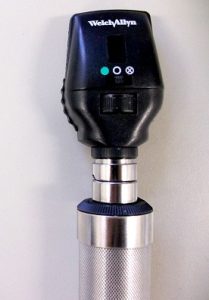
Key Concept
Fig. 1.6 is an image of an ophthalmoscope, an instrument used to view and assess the eye. The term means an “instrument” (scope) to view the “eye” (ophthalm/o). In this term, you keep the combining vowel because the suffix starts with a consonant.
Also, notice the combining form nat/i, meaning “birth,” in the table above. It is one of the few combining forms where the vowel is an i, not an o.
Exercises
Table 1.5. Combining Forms
| COMBINING FORM | MEANING | EXAMPLE OF USE IN MEDICAL TERMS |
|---|---|---|
| path/o | disease | pathology |
| pelv/o | pelvis | pelvic |
| peritone/o | peritoneum | peritoneal |
| phleb/o | vein | phlebitis |
| plas/o | formation, growth, development | neoplastic |
| pneumon/o | lung | pneumonitis |
| psych/o | mind | psychosis |
| pulmon/o | lung | pulmonary |
| radi/o | X-ray | radiotherapy |
| ren/o | kidney | renal |
| rhin/o | nose | rhinorrhea |
| salping/o | fallopian tube | salpingectomy |
| sarc/o | flesh | sarcoma |
| scapul/o | shoulder blade | subscapular |
| septic/o | infection | septicemia |
| son/o | sound | ultrasonography |
| thorac/o | chest | thoracic |
Key Concept
Septicemia means “blood infection,” or literally “blood condition,” from the suffix -emia, and the combining form septic/o, which means “infection.” Septicemia is one of the most serious infections you might see in patients. Depending on when it is identified and the type of infection, the mortality rate can be up to 50% (John Hopkins Medicine, 2022a).
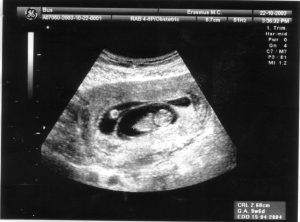
Key Concept
Fig. 1.7 is an image of a fetus created using ultrasonography. An ultrasound can be completed on many locations of the body for diagnostic purposes. The term ultrasonography means “process of recording” (-graphy) “beyond” (ultra-) “sound” (son/o).
Exercises
Table 1.6. Combining Forms
| COMBINING FORM | MEANING | EXAMPLE OF USE IN MEDICAL TERMS |
| thyroid/o | thyroid gland | hyperthyroidism |
| tonsill/o | tonsil | tonsillitis |
| top/o | to put, to place, to position | ectopic |
| thromb/o | clotting | thrombocyte |
| trache/o | windpipe (trachea) | tracheotomy |
| ur/o | urine or urea, urinary tract | uremia |
| urethr/o | urethra | urethritis |
| uter/o | uterus | intrauterine |
| vascul/o | blood vessel | vascular |
| ven/o | vein | intravenous |
Key Concept
The combining form ur/o means “urine” or “urea.” In the term uremia, ur/o means “urea.” This term means “blood condition” (-emia) with “urea” (ur-). Urea is a waste product in blood that builds up when the kidneys are not functioning properly (Betts et al., 2013).
The term uremia often gets confused with the term hematuria; however, hematuria means “a condition of urine” (-uria) with “blood” (hemat-) (Ansorge, 2022).
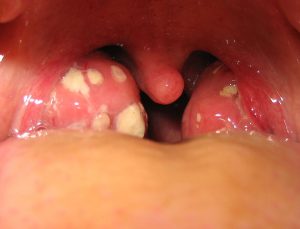
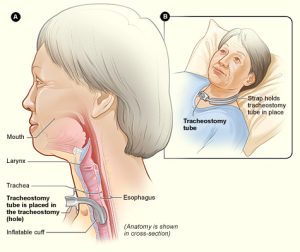
Key Concepts
Fig. 1.8 is an image of inflamed tonsils, or tonsillitis. This term means “inflammation” (-itis) of the “tonsils” (tonsill/o).
Fig. 1.9 is an image of a tracheostomy. This term means an “opening” (-stomy) into the “trachea” (trache/o). There are a number of medical conditions that require a patient to have a tracheostomy, including major burns, long-term comas, and certain types of tumours (John Hopkins Medicine, 2022b).
Exercises
Attribution
Unless otherwise indicated, material on this page has been adapted from the following resource:
Carter, K., & Rutherford, M. (2020). Building a medical terminology foundation. eCampusOntario. https://ecampusontario.pressbooks.pub/medicalterminology/ licensed under CC BY 4.0
References
Ansorge, R. (2022). Blood in urine (hematuria). WebMD. https://www.webmd.com/digestive-disorders/blood-in-urine-causes
Betts, J. G., Young, K. A., Wise, J. A., Johnson, E., Poe, B., Kruse, D. H., Korol, O., Johnson, J. E., Womble, M., & DeSaix, P. (2013). Anatomy and physiology. OpenStax. https://openstax.org/details/books/anatomy-and-physiology licensed under CC BY 4.0.
John Hopkins Medicine. (2022a). Septicemia. https://www.hopkinsmedicine.org/health/conditions-and-diseases/septicemia#:~:text=Septicemia%2C%20or%20sepsis%2C%20is%20the,the%20type%20of%20organism%20involved
John Hopkins Medicine. (2022b). Tracheostomy service. https://www.hopkinsmedicine.org/tracheostomy/about/reasons.html#:~:text=A%20tracheostomy%20is%20usually%20done,deliver%20oxygen%20to%20the%20lungs
Image Credits
(Images are listed in order of appearance)
Osteoarthritis by BruceBlaus, CC BY-SA 4.0
Cerebrum lobes by CSSKG, CC BY-SA 4.0
EEG cap by Thuglas, Public domain
SEM_blood_cells by Bruce Wetzel, Public domain
Exploratory Laparotomy Scar by jessica raphaela, CC BY-SA 2.0
Ophthalmoscope by Joyce Tiu, CC BY-SA 4.0
2003-10-22 Echo Tweeling-01 by DESIDERIUS, Public domain
Tonsillitis by Michaelbladon, Public domain
Tracheostomy NIH by National Heart, Lung, and Blood Institute (NHLBI), Public domain
Pertaining to the abdomen
A mass or tumour in a gland
A surgical puncture to remove fluid from the amniotic sac
Pertaining to the anus
Removal of the appendix
A record of the blood vessels
The hardening of an artery
Hardening (of the arteries) with plaque
Inflammation of the joints
Pertaining to the armpit
The study of life
Inflammation of the bronchial tubes
A chronic condition in which the walls of the bronchi thicken because of inflammation and infection
A cancerous mass or tumour
The study of the heart
Pertaining to the wrists
Pertaining to the head
Pertaining to a cerebrum blood vessel accident, which is commonly known as a stroke or abbreviated as CVA
Treatment with drugs
Removal of the gallbladder
Pertaining to time; sometimes meaning over a period of time
Inflammation of the colon
Pertaining to between the ribs
Cutting into the skull
Treatment with cold
Pertaining to the skin
An instrument to visually examine the urinary bladder
The study of cells
Pertaining to the skin
The study of the skin
Pertaining to upon the dura mater
A record of electricity in the heart
A record of electricity in the brain
Inflammation of the intestines
A cell that is red; red blood cell
Pertaining to the esophagus
The condition of pain in the stomach
The condition of high blood sugar
A state of complete knowledge (this term is an exception to the rules; the suffix -sis means "state of")
The study of women
A protein in the blood that carries oxygen
The study of blood
Inflammation of the liver
Removal of the uterus
Pertaining to the groin
Blood held back or to hold back blood
Cutting into the abdomen
Inflammation of the larynx
Pertaining to the side
A cell that is white; white blood cell
The process of recording an X-ray of the breast
Removal of one or both breasts
Discharge or flow of menses; normal menstrual flow
Inflammation of the meninges
The condition of pain in the muscles
A malignant tumour in the bone marrow
Pertaining to new birth
An abnormal condition of death
Inflammation of the kidneys
The condition of pain in the nerves
The study of tumours
Removal of the ovaries
The process of visually examining the eye
Inflammation of the bones and joints
The condition of pain in the ear
The study of disease
Pertaining to the pelvis
Pertaining to the peritoneum
Inflammation of the vein
Pertaining to new growth (note that the spelling is an exception to the rules)
Inflammation of the lungs
An abnormal condition of the mind
Pertaining to the lungs
Treatment with X-rays
Pertaining to the kidneys
Discharge from the nose
Removal of the fallopian tubes
A tumour or mass in the flesh
Pertaining to below the scapula
Infection of the blood
The process of recording beyond sound
Pertaining to the chest
A condition of high thyroid
Inflammation of the tonsils
Pertaining to out of place or position; often used in reference to an ectopic pregnancy, which is a pregnancy that occurs outside its normal location in the uterus
A cell that clots (platelet)
To cut into the windpipe (trachea)
A blood condition with urea (a waste product)
Inflammation of the urethra
Pertaining to within the uterus
Pertaining to the blood vessels
Pertaining to within a vein

